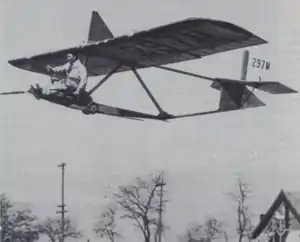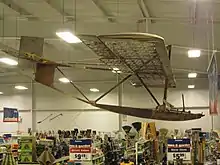| G1 Gull | |
|---|---|
 | |
| G1 Gull on tow | |
| Role | Primary glider |
| National origin | United States |
| Manufacturer | Detroit Aircraft Corporation |
| First flight | 1925 |
| Introduction | circa 1930s |
| Status | No longer in production |
| Number built | At least three |
The Detroit G1 Gull is an American high wing, cable-braced primary glider that was manufactured by the Detroit Aircraft Corporation during the Great Depression.[1] It first flew in 1925.[2]
The aircraft's correct designation is not clear. Soaring Magazine calls it the Detroit Gull G1 Primary, while the two Federal Aviation Administration registered aircraft are simply Detroit Gulls. Henley's ABC of Gliding and Sailflying also calls it the Detroit Gull.[1][3][4][5]
Design and development
The Gull G1 was developed by Detroit Aircraft as an inexpensive aircraft for the Depression. Detroit Aircraft later sold the rights to Stone Aircraft, who sold plans for the aircraft for amateur construction.[1]
The Gull is built from wood, with the tail and wing surfaces covered in doped aircraft fabric. The wing is cable braced from a kingpost. The fuselage consists of a simple structure to which the seat is attached. The pilot sits on the completely open seat, with no windshield. Controls are conventional three-axis. The landing gear consists of the bottom of the fuselage shaped into a long wooden skid . Sometimes two small wheels were attached.[1]
The Gull was reportedly type certified, but no record of the type certificate is on file with the Federal Aviation Administration.[1][6]
Operational history
One Gull was started before the Second World War by Peter Eyrud of Walla Walla, Washington, but not completed. This aircraft was purchased by Peter M. Bowers who completed and flew it. Bowers documented the aircraft project in an article in the March/April 1957 edition of Soaring Magazine entitled Don't Build a Primary.[1]
In 1983 two other Gulls were reported to be in storage awaiting restoration.[1]
In May 2011 there were two G1 Gulls registered with the Federal Aviation Administration in the USA. One was in the Kansas Aviation Museum and the other was still registered to Peter M. Bowers, even though he died in April 2003. Soaring Magazine reports that this aircraft too is actually in an unnamed aviation museum.[3][4]
In August, 2013 one was put on display at the W.L Zimmerman's Hardware Store, Intercourse, Pennsylvania. This glider has been preserved in original condition from 1931.


Aircraft on display
- Kansas Aviation Museum[3]
- W.L Zimmerman and Sons Hardware Store, Intercourse, Pennsylvania
Specifications (G1)
Data from Soaring and Henley[1][5]
General characteristics
- Crew: one
- Length: 17.5 ft (5.3 m)
- Wingspan: 34.5 ft (10.5 m)
- Height: 7.0 ft (2.1 m)
- Wing area: 170 sq ft (16 m2)
- Aspect ratio: 7:1
- Airfoil: USA 35
- Empty weight: 200 lb (91 kg)
- Gross weight: 400 lb (181 kg)
Performance
- Never exceed speed: 103 mph (166 km/h, 90 kn)
- Maximum glide ratio: 8:1 at 30 mph (48 km/h)
- Wing loading: 2.36 lb/sq ft (11.5 kg/m2)
See also
Aircraft of comparable role, configuration, and era
Related lists
References
- 1 2 3 4 5 6 7 8 Said, Bob: 1983 Sailplane Directory, Soaring Magazine, page 40. Soaring Society of America November 1983. USPS 499-920
- ↑ "J2mcL Planeurs - Fiche planeur n°". www.j2mcl-planeurs.net. Retrieved June 15, 2022.
- 1 2 3 Federal Aviation Administration (May 2011). "Make / Model Inquiry Results". Archived from the original on July 27, 2012. Retrieved May 7, 2011.
- 1 2 Federal Aviation Administration (May 2011). "Make / Model Inquiry Results". Archived from the original on February 23, 2019. Retrieved May 7, 2011.
- 1 2 Page, Major Victor W.: Henley's ABC of gliding and sailflying, page 123. 1931."Henley's ABC of Gliding and Sailflying" (PDF).
- ↑ Federal Aviation Administration (May 2011). "Type Certificate Data Sheets Inquiry Results". Retrieved May 7, 2011.